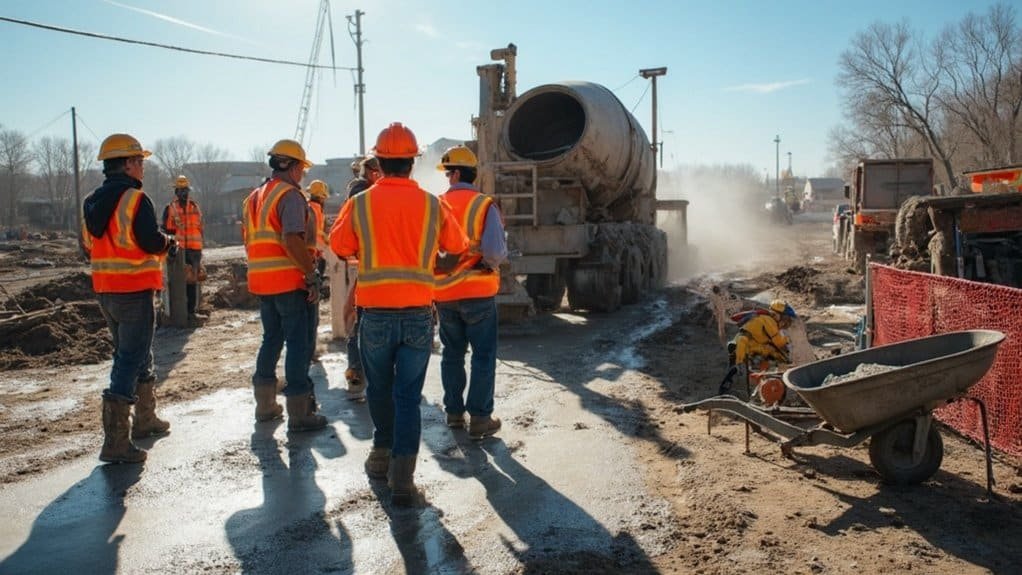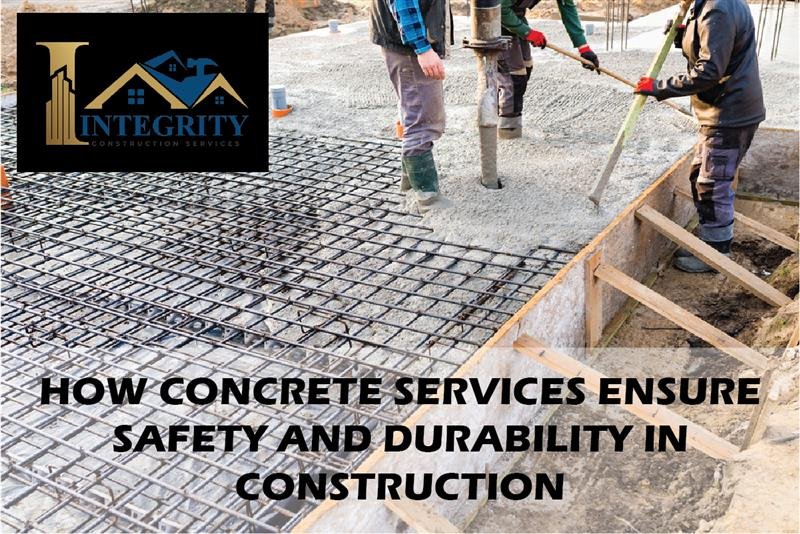Concrete is way more than just that gray stuff underfoot—it’s the backbone of modern construction, powering everything from towering skyscrapers to humble sidewalks. When concrete services step in, they champion safety and durability through expert mix design, quality control, reinforcement, and proper curing. That means fewer cracks, greater structural integrity, and long-lasting performance. In fact, the right concrete mix and treatment dramatically reduce wear, withstand environmental stress, and ensure building safety. Whether it’s mastering the curing process or reinforcing with steel, every step counts. In this post, we’ll explore how concrete services elevate construction projects—keeping structures safe, robust, and built to stand the test of time.
Mix Mastery That Strengthens Your Structure – Build with Confidence
Concrete begins with the right blend. Concrete services bring technical know-how to mix design, balancing cement, sand, aggregates, and water. They tailor mix proportions to match project needs—whether high-strength structural slabs or abrasion-resistant pavement. By doing so, they optimize compressive strength and help control shrinkage and cracking. When service providers use precision batching, they ensure consistency across pours. That means uniform curing behavior and minimized weak spots. Plus, mix mastery lowers permeability, enhancing resistance to freeze-thaw cycles, chemical attack, and wear.
Moreover, mix design experts often add admixtures—fly ash, silica fume, superplasticizers—to boost workability and long-term strength. These ingredients also help with hydration control and reduce cement demand, cutting carbon footprint. By customizing mix design, concrete services offer both durability and sustainability. In turn, your structure resists environmental stress, retains integrity longer, and ultimately demands less maintenance.
Quality Control in Action – Test, Check, Succeed
Concrete quality control isn’t optional—it’s mission-critical. Concrete services routinely perform slump tests, compressive strength tests, and air content testing to verify the mix behaves as intended. Through on-site sampling and lab testing, they ensure the concrete meets industry standards and project specifications. This proactive approach catches potential issues early—so you avoid weak pours, durability problems, or compliance failures.
Active quality control extends from raw materials to finished product. Inspectors monitor aggregate gradation, cement fineness, and water quality, making adjustments on the fly. They verify that the reinforcement is placed correctly, that formwork is sound, and that vibration during placement is sufficient. This relentless focus on checks ensures the concrete cures into a solid, safe structural element—ready to bear load, resist cracking, and contribute long-term reliability to your project.
Reinforcement Integration – Steel Meets Concrete for Safety

Concrete on its own lacks substantial tensile strength, which is why reinforcing bars (rebar) or steel mesh is vital. Concrete services expertly coordinate reinforcement design and installation to complement compressive capacity with tensile resilience. They design where rebar must go—within slabs, beams, columns—and ensure proper placement and coverage to avoid corrosion and maintain bonding.
During concrete placement, skilled crews maintain rebar spacing, secure ties, and ensure rebar doesn’t shift. That achieves the correct concrete-to-steel bond, maximizing load transfer and structural ductility. Reinforced concrete resists bending, shear, seismic forces, and dynamic loads far better than plain concrete. By combining mix design with reinforcement, concrete services deliver strong, safe, and durable structures that adapt to stress rather than crack or fail.
Expert Curing Techniques – Let Concrete Mature for Longevity
Curing is a savior, not an afterthought. Proper curing preserves moisture, controls temperature, and supports hydration—leading to stronger, less permeable concrete. Concrete services deploy curing methods like water ponding, wet coverings, curing compounds, and even insulated blankets in cold weather. Each method ensures that concrete doesn’t dry too fast—preventing shrinkage cracks, surface dusting, and reduced long-term strength.
Additionally, services monitor ambient conditions—temperature, humidity, wind—and adapt curing plans in real-time. For hot climates, they might shade the concrete, cool mixing water, or apply misting systems. In cold, they may use heated enclosures or accelerators. By actively managing curing, concrete matures with uniform strength and enhanced durability, reducing maintenance and extending structure life. That level of commitment ensures the concrete doesn’t just look good—it endures.
Site Safety and Compliance – Building Trust and Protection
Concrete services don’t just protect structures—they protect people. Through precise mix, reinforcement, placement, and curing, they mitigate risks like premature cracking, batch inconsistency, and formwork failure. Plus, by following OSHA guidelines and construction standards (ACI, ASTM), they help enforce site safety protocols. Proper planning reduces accidents—forms don’t collapse, vibrations stay within safe limits, and handling loads happen with care.
Moreover, concrete providers often help with quality documentation: batch tickets, test reports, and compliance certificates. That transparency enhances accountability and trust—especially on large construction sites. Ultimately, when concrete services operate with safety in mind, the whole project benefits: fewer delays, liability reduction, and confidence that your build is solid.
Sustainability Meets Durability – Making Concrete Green and Tough
Concrete services play a vital role in sustainable construction—through mix optimization, waste reduction, and supplementary cementitious materials. By integrating fly ash, slag, or recycled aggregates, they lower carbon footprint and use materials more efficiently. Reducing cement demand not only cuts emissions but also enhances long-term performance, as many SCMs improve durability.
They also minimize waste by calculating material needs precisely, managing leftover concrete (recycler systems), and reusing formwork. And energy-efficient curing systems (like insulating blankets) save fuel in cold days. In effect, concrete services give you the dual benefit: structures that endure decades and tread lightly on the environment. That balance is essential for modern construction goals.
Long-Term Monitoring and Maintenance Planning – Keep It Standing
Your structure’s safety and durability extends beyond curing day. Concrete services often advise or support long-term health monitoring—like crack mapping, core testing, or surface inspections. They guide maintenance planning—what sealers to apply, when to reseal expansion joints, and how to address minor spalling.
By understanding concrete’s lifecycle, they help you schedule preventative work before small issues escalate. That might mean resealing permeable surfaces, patching cracks early, or resurfacing worn areas. With their knowledge of concrete behavior under load and environment, concrete services translate into preservation of structural integrity—and budget-friendly long-term performance.
Value-Driven Expertise—Why Hiring Pros Pays Off

Hiring professional concrete services is an investment, not a cost. Their expertise in mix design, quality control, reinforcement, curing, compliance, and sustainability saves you time, budget, and problems down the road. Effective concrete means fewer repairs, lower risk, and longer life.
Moreover, professional services adapt to project complexity—be it high-rise foundations, bridge decks, or decorative overlays. They align with engineering specs, construction timelines, and environmental challenges. And their documented results protect your bottom line and reputation. In short, expert concrete services ensure you deliver safe, durable, high-quality structures—building trust with clients and communities alike.
Wrap-Up
Bringing it all together, concrete services are the unsung heroes of construction—they fine-tune mix design, enforce quality control, integrate reinforcement, and master curing to create safe, long-lasting structures. Their focus on sustainability and site safety builds trust while reducing environmental impact. Plus, their long-term maintenance advice keeps buildings standing strong with minimal upkeep. By bringing in skilled professionals, you elevate construction from just getting the job done to building with confidence, resilience, and integrity. Whether you’re pouring a foundation or topping a skyscraper, these services are key to ensuring structural safety and concrete durability. When you invest in quality concrete service, you’re investing in a future that stands firm, safe, and sustainable.
FAQs
Q1: What is the most important factor in ensuring concrete durability?
A: Mix design is fundamental—getting the right balance of cement, water, aggregates, and admixtures determines strength, permeability, and shrinkage behavior. But it works hand in hand with proper curing and reinforcement for full durability.
Q2: How long should I cure concrete for max strength?
A: Generally, concrete reaches about 70–80% of its strength in the first 7 days; full curing often takes 28 days. However, with admixtures or weather conditions, curing might extend longer—so follow service provider advice tailored to your project.
Q3: Can recycled materials affect safety and durability?
A: When incorporated correctly by experts, SCMs like fly ash or slag can enhance durability and reduce carbon footprint without compromising safety—often improving resistance to chemicals and reducing permeability.
Q4: How do I know if my concrete service is doing quality control properly?
A: Look for regular slump and strength tests, documentation of batch compliance, on-site inspections of formwork and reinforcement, and evidence of curing protocols. Transparent records and proactive adjustments indicate good QC.


I have been exploring for a bit for any high quality articles or weblog posts in this sort of space . Exploring in Yahoo I ultimately stumbled upon this website. Reading this information So i am satisfied to convey that I have a very just right uncanny feeling I discovered exactly what I needed. I so much without a doubt will make certain to don?¦t overlook this site and provides it a look regularly.
You have mentioned very interesting details! ps nice website . “It is better to be hated for who you are than to be loved for what you are not.” by Andre Gide.
Good write-up, I am normal visitor of one’s site, maintain up the nice operate, and It is going to be a regular visitor for a lengthy time.
You have brought up a very superb points, appreciate it for the post.
obviously like your website but you need to test the spelling on quite a few of your posts. Several of them are rife with spelling issues and I in finding it very bothersome to tell the reality nevertheless I will surely come again again.